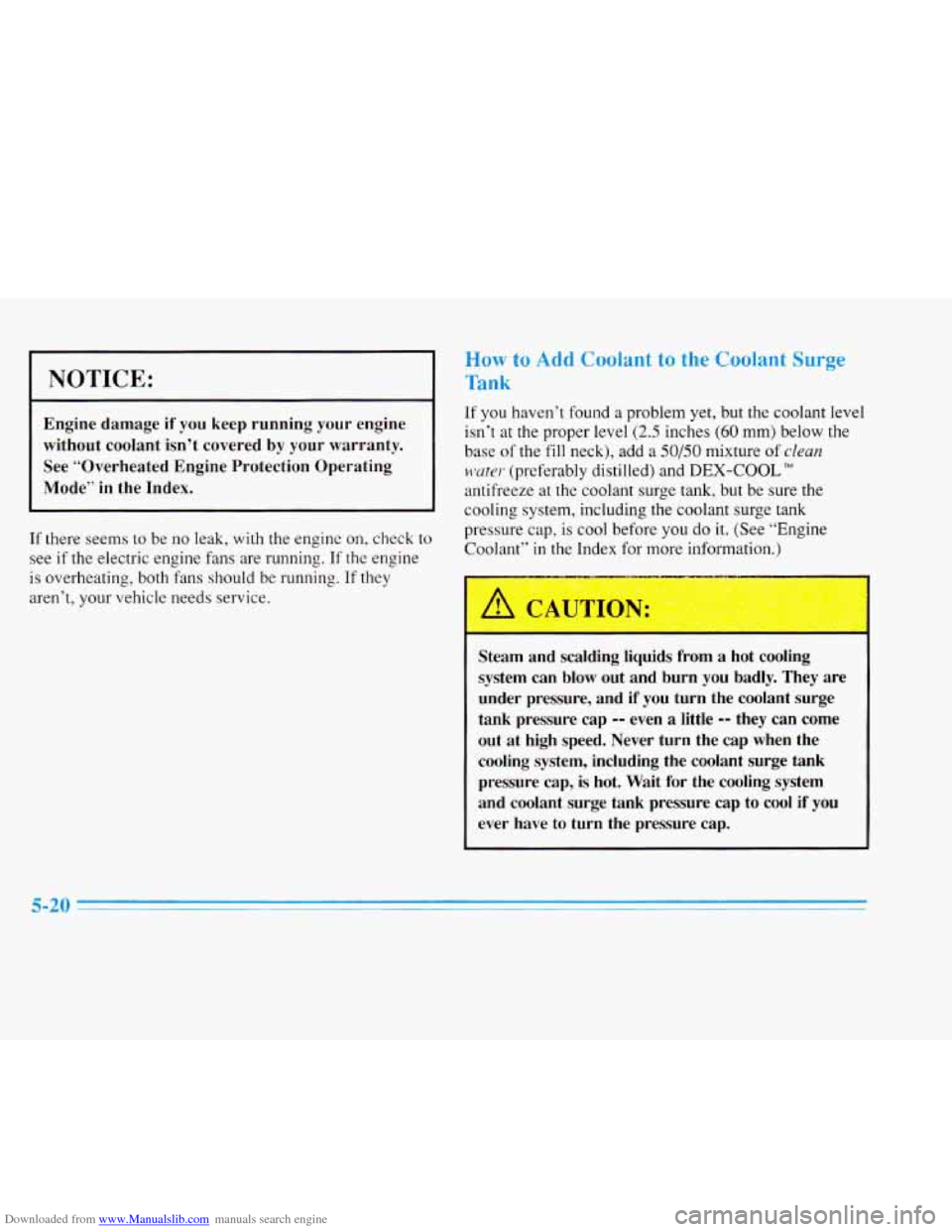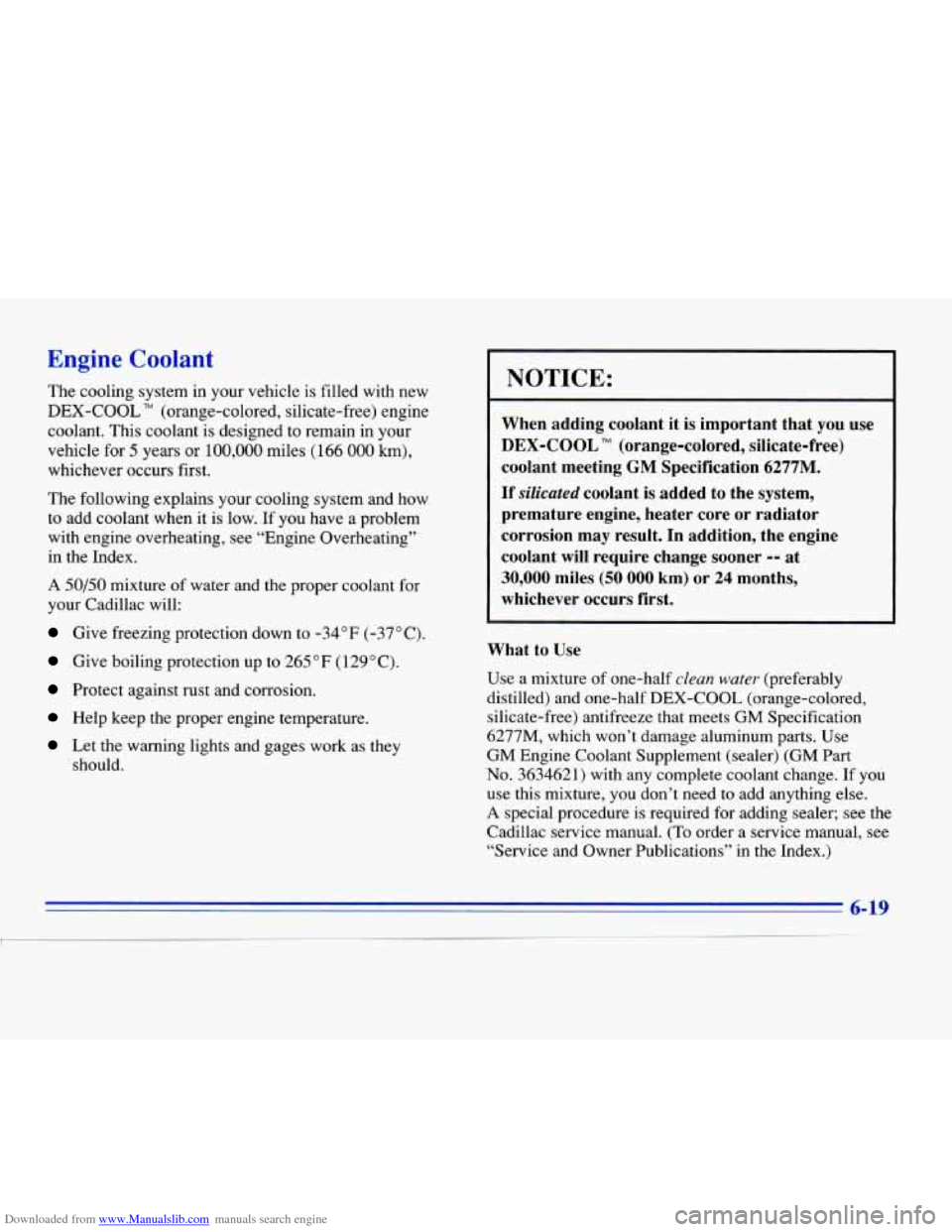Page 241 of 354

Downloaded from www.Manualslib.com manuals search engine NOTICE:
Engine damage if you keep running your engine
without coolant isn’t covered by
your warranty.
See “Overheated Engine Protection Operating
Mode” in the Index.
If there seem to be no leak, with the engine on, check to
see if the electric engine fans are running. If the engine
is overheating, both fans should be running. If they
aren’t, your vehicle needs service.
How to Add Coolant to the Coolant Surge
Tank
If you haven’t found a problem yet, but the coolant level
isn’t at the proper level
(2.5 inches (60 mm) below the
base
of the fill neck), add a 50/50 mixture of cleun
water (preferably distilled) and DEX-COOL TM
antifreeze at the coolant surge tank, but be sure the
cooling system, including the coolant surge tank
pressure cap, is cool before
you do it. (See “Engine
Coolant’’ in the Index for more information.)
Steam and scalding liquids from a hot cooling
system can blow out and burn you badly. They are
under pressure, and if you turn the coolant surge
tank pressure cap
-- even a little -- they can come
out at high speed. Never turn the cap when the
cooling system, including the coolant surge tank
pressure cap,
is hot. Wait for the cooling system
and coolant surge tank pressure cap to
cool if you
ever have to turn the pressure cap.
Page 242 of 354
Downloaded from www.Manualslib.com manuals search engine Adding only plain water to your cooling system
can be dangerous. Plain water, or some other
liquid like alcohol, can boil before the proper
coolant mix will. Your vehicle’s coolant warning
system is set for the proper coolant mix. With
~ plain water or the wrong mix, your engine could
get too hot but you wouldn’t get the overheat
warning. Your engine could catch fire and you or
others could be burned. Use
a 50/50 mix of clean
water and
DEX-COOL TM antifreeze.
5-21
Page 243 of 354
Downloaded from www.Manualslib.com manuals search engine NOTICE:
In cold weather, water can freeze and crack the
engine, radiator, heater core and other parts.
So
use the recommended coolant.
You can be burned if you spill coolant on hot
engine parts. Coolant contains ethylene
glycol
and it will burn if the engine parts are hot
enough. Don’t spill coolant on
a hot engine.
1. You can remove the coolant surge tank pressure
cap when the cooling system, including the coolant
surge tank pressure cap
and upper radiator hose,
is
no longer hot. Turn the pressure cap slowly
counterclockwise until
it first stops. (Don’t press
down while turning the pressure cap.)
If you hear a hiss, wait for that to stop. A hiss means
there is still some pressure left.
Page 244 of 354
Downloaded from www.Manualslib.com manuals search engine I
2. Then keep turning the cap, but now push down as
you turn it. Remove the pressure cap.
3. Then fill the coolant surge tank with the properfmix,
up to the base
of the filler neck.
5-23
Page 245 of 354
Downloaded from www.Manualslib.com manuals search engine 4. With the coolant surge tank pressure cap oft', start the 5. Then replace the pressure cap. Be sure the arrows on
engine and let it run until you can feel
the upper the pressure cap line up like this.
radiator hose getting hot. Watch out for the
engine fans.
By this time, the coolant level inside the coolant Driver Information Center, coolant
is at the proper fill
surge tank may be lower.
If the level is lower, add level. If a CHECK COOLANT LEVEL message does
more
of the proper mix to the coolant surge tank appear, repcat Steps 1 to 3 or see your dealer.
until the level reaches about
2.5 inches (60 mm)
below the base
of the filler neck. Start
the engine and allow
it to warm up. If the CHECK
COOLANT LEVEL message does not appear on the
Page 266 of 354
Downloaded from www.Manualslib.com manuals search engine 1
Things that burn can get on hot engine parts and
start
a fire. These include liquids like gasoline,
oil, coolant, brake fluid, windshield washer and
other fluids, and plastic or rubber.
You or others
could be burned. Be careful not to drop or mill
things that will burn onto
a hot engine.
Hood Release
Pull the lever inside the
vehicle to open the hood.
It I
is located on the lower left
side of the instrument panel. Then
go to the front
of the vehicle and find the
secondary
hood release which is located under the front
edge of the grille. Lift
up on the release lever as you
raise the hood.
Page 267 of 354
Downloaded from www.Manualslib.com manuals search engine When you open the hood, you'll see:
G. Transaxle Dipstick/FiIl
H. Air Cleaner
I. Windshield Wdsher Fluid
A. Battery
B. Coolant Fill Location
C. Power Steering Fluid D.
Oil Fill Location
E. Engine Oil Dipstick Location
E Brake Master Cylinder
Before closing the hood, be sure all filler caps are on properly. Then pull the hood down and close it firmly.
Page 278 of 354

Downloaded from www.Manualslib.com manuals search engine Engine Coolant
The cooling system in your vehicle is filled with new
DEX-COOL TM (orange-colored, silicate-free) engine
coolant. This coolant is designed to remain in your
vehicle for
5 years or 100,000 miles (166 000 km),
whichever occurs first.
The following explains your cooling system and how
to add coolant when it is low. If you have a problem
with engine overheating, see “Engine Overheating”
in the Index.
A 50/50 mixture of water and the proper coolant for
your Cadillac will:
Give freezing protection down to -34°F (-37°C).
Give boiling protection up to 265°F (129°C).
Protect against rust and corrosion.
Help keep the proper engine temperature.
Let the warning lights and gages work as they
should.
NOTICE:
When adding coolant it is important that you use
DEX-COOL (orange-colored, silicate-free)
coolant meeting
GM Specification 6277M.
If silicated coolant is added to the system,
premature engine, heater core or radiator
corrosion may result. In addition, the engine
coolant will require change sooner
-- at
30,000 miles (50 000 km) or 24 months,
whichever occurs first.
What to Use
Use a mixture of one-half clean water (preferably
distilled) and one-half
DEX-COOL (orange-colored,
silicate-free) antifreeze that meets GM Specification
6277M, which won’t damage aluminum parts. Use
GM Engine Coolant Supplement (sealer) (GM Part
No. 3634621) with any complete coolant change. If you
use this mixture, you don’t need to add anything else.
A special procedure is required for adding sealer; see the
Cadillac service manual.
(To order a service manual, see
“Service and Owner Publications” in the Index.)
6-19